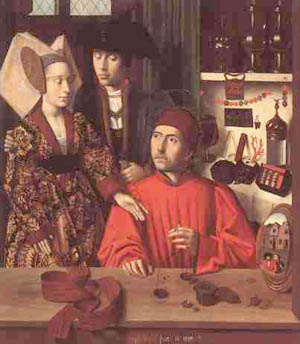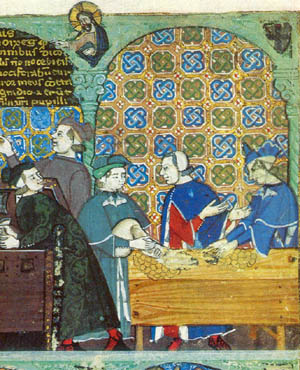 |
The Saint of the Day
St. Eligius (Eloi or Eloy) – December 1
Prof. Plinio Corrêa de Oliveira
Biographical selection:
St. Eligius lived from 588 to 660. He was born in Limoges, France, and from an early age revealed an unusual talent in craftsmanship. He was an apprentice under a noted goldsmith, and came to be one of the best craftsmen of his time.

Above, St. Eligius in his goldsmith shop, by Petrus Christus, 1449. Below, a goldsmith's work from the 5th or 6th century

|
The case of the throne he made for King Clotaire II became famous. Clotaire commissioned Eligius to make a throne of gold inlaid with precious stones. With the gold he received to make the piece, Eligius was able to craft two precious thrones. Pleased by such honesty, the king took him into his household and appointed him master of the treasury, in charge of minting the coins of the kingdom. Clotaire died in 629 and was succeeded by his son Dagobert, who also took St. Eligius into his confidence and named him his chief councilor.
The Bretons were making incursions into the land of the Franks (Neustria), and King Dagobert sent St. Eligius to the King of the Bretons, St. Judicail, to ask him to submit to Frankish authority. The mission was a complete success. The Breton King and his nobles agreed to pay homage to King Dagobert. Returning to his kingdom, King Judicail renounced the crown and entered a monastery.
St. Eligius felt the same attraction to the monastic life, but he was not permitted to leave his civil duties. Often, however, when his functions as minister of the King permitted, he would leave the court and go to Luxeil, a great monastery to admire the order of monastic life. During his trips, he used to order all the poor people of the area to gather before him to receive alms. He would order meals prepared for the poor and then he would personally serve them. Afterward, he used to wash their feet and prepare beds for them.
In 639, on the death of King Dagobert, St. Eligius finally left the court to become a priest. One year later, he was named the new Bishop of Noyon-Tournai. From there he went to many parts of Flanders where idolatry still reigned to preach the word of God to those pagans. Faced with the obstinacy of the inhabitants, he destroyed their idols and founded many churches and monasteries. According to tradition, he worked many miracles.
One day, for example, on the feast of St. Peter, he was preaching against paganism and idolatry in one of those villages. Some of the village leaders threatened to kill him unless he stopped speaking. Instead of fleeing, St. Eligius spoke with redoubled emphasis against their diabolical superstitions. The mob took up stones to kill him, but with a loud voice that rose above the rabble, he spoke this prayer:
“Lord, I beg Thee to deliver to the Devil the souls of these audacious men who dare resist Thy precepts. By the torments the Devil will inflict upon them, they will learn to respect Thy infinite power and give glory to Thy Name.”
Immediately, some 50 of the more insolent of his attackers were possessed by the Devil. The rest of the multitude, fearing the same fate would fall upon them, knelt before the Saint, promising to do whatever he would command. St. Eligius calmed the mob, but did not free any of those possessed men. The next year, however, on the same feast day of St. Peter, he ordered the 50 unfortunate persons to come before him. Then he prayed to God and sprinkled them with Holy Water. The Devil left their souls, and from this incident, the whole region converted.
Comments of Prof. Plinio:
The personality of St. Eligius is very rich with many aspects that should be analyzed separately.
First, it is interesting to see how St. Eligius had no trace of the modern religious mentality, which dictates that no saint should approve the pomp and richness of both the State and the Church. The spirit of St. Eligius was the opposite of this false mentality. His sanctity shone with the same splendor both when he crafted two precious gold thrones for the king and when he gave alms to the poor. He had a perfect balance in this regard.

Above, 7th century coins with effigies of Kings Clotaire, left, and Dagobert. Below, a scene from the office of the treasury.

|
Second, St. Eligius was a part of the household and the treasury minister of Kings Clotaire II and Dagobert because, at that time, the domestic functions of the king’s household coincided with State functions. The man who was in charge of the king’s stables, for instance, was also in charge of all the chivalry units of the kingdom. He was a kind of minister of defense. So, St. Eligius, because of his honesty in making the king’s throne, was chosen to be his goldsmith and, as a consequence, the master of the mint. He was a kind of minister of economy. He was at the same time a skillful diplomat.
Third, the episode telling how St. Eligius treated the poor shows not only his admirable charity, but also how different the customs of those times were. We can see how tranquil the life of a minister of State was then. He had the time to have dinner with the poor, serve them, and prepare beds for them. St. Eligius had time for that, while a present day minister does not.
In part this is because the modern State is intrusive, designed to control everything, and its ministers are overwhelmed by enormous responsibilities. If the State were governed by the principle of subsidiarity, it would only involve itself in indispensable affairs, when it would be absolutely necessary. Many responsibilities would be naturally in the hands of individuals or particular groups, and the ministers would have time to live and breathe.
Fourth, the poor of that time also were completely different from today’s poor. If a minister would seat himself at the table of a mass of poor today, he would run the serious risk of being swarmed by protests and objections, and perhaps even being hurt. At that time there were ministers who sincerely loved the poor, and the poor, in return, loved them and treated them with consideration and respect. It was an epoch of social harmony, not an epoch where class struggle was introduced everywhere by Communism.

St. Eligius, a model of justice and mercy |
Fifth, we can better understand the magnificent lesson St. Eligius gave to that pagan village by pointing out how a person who is possessed by the Devil is tormented by him: he hurts himself rolling on the ground; he spoils his health eating disgusting things, he flees society and hides in solitary, filthy places; he scares people imitating the sound of animals, etc. To be possessed by the Devil for one year is the worst chastisement of both body and soul that one can imagine.
Well, St. Eligius, in a very anti-ecumenical spirit, prayed to God that the Devil would possess those persons in order to teach the village a good lesson. He gave us an example of a strong and well-oriented charity. At the end of one year, the whole area had converted.
I can already see the hysterical objections of many progressivists to this episode from St. Eligius’s life. But such reactions are of no import. They only prove how the progressivists are wrong and have a spirit different from the Catholic spirit. St. Eligius loses none of his glory because of their attacks. He continues to be highly venerated in many places as an example of goodness. By the way, it was his goodness that in great part created the fame of “good King Dagobert,” about whom the French children sing in a very popular and charming song until today.
Let us ask St. Eligius to give us the balance between justice and mercy he so wisely exercised so that we may show goodness to the good and force against the evil to better serve Our Lady, as he did.


  | | Prof. Plinio Corrêa de Oliveira | |
The Saint of the Day features highlights from the lives of saints based on comments made by the late Prof. Plinio Corrêa de Oliveira. Following the example of St. John Bosco who used to make similar talks for the boys of his College, each evening it was Prof. Plinio’s custom to make a short commentary on the lives of the next day’s saint in a meeting for youth in order to encourage them in the practice of virtue and love for the Catholic Church. TIA thought that its readers could profit from these valuable commentaries.
The texts of both the biographical data and the comments come from personal notes taken by Atila S. Guimarães from 1964 to 1995. Given the fact that the source is a personal notebook, it is possible that at times the biographic notes transcribed here will not rigorously follow the original text read by Prof. Plinio. The commentaries have also been adapted and translated for TIA’s site.
|
Saint of the Day | Home | Books | CDs | Search | Contact Us | Donate

© 2002- Tradition in Action, Inc. All Rights Reserved
|
 |

|